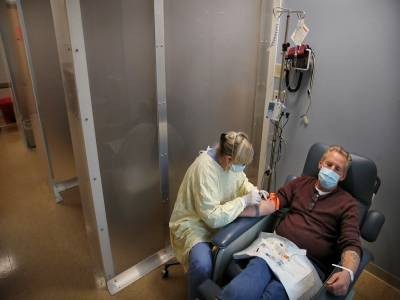Las células T 'asesinas' todavía reconocen Omicron
‘Killer’ immune cells still recognize Omicron variant
When immunologists Wendy Burgers and Catherine Riou heard about the Omicron coronavirus variant last November, they knew they would need to find the answers to some important questions. Omicron’s genome is loaded with mutations — more than 30 in the region that codes for the spike protein, used in COVID-19 vaccines — meaning that the efficacy of antibodies raised against previous variants could be compromised.
Burgers and Riou, who both work at the University of Cape Town in South Africa, had studied previous variants and found that, although the emerging coronaviruses weakened people’s antibody defences, another arm of the immune system — mediated by specialized cells called T cells — could still recognize the pathogens. But Omicron was more heavily mutated than any variant they’d studied before. How might this affect the immunity, hard won through vaccinations and previous infections, that populations were counting on to lessen the blow of COVID-19 surges? “With two to three times the amount of mutations, that made us think, ‘Hmmm, we need to answer this question pretty quickly,’” says Burgers.
Since then, answers are beginning to come from a handful of laboratories around the world, and all converge on the same message. “The picture that’s emerging is that [new] variants remain highly susceptible to T-cell responses,” says Dan Barouch, director of the Center for Virology and Vaccine Research at Harvard Medical School in Boston, Massachusetts. “That includes Omicron.”
Lasting immunity
When it comes to coronavirus immunity, antibodies have stolen the limelight. Researchers are monitoring people’s levels of antibodies — particularly ‘neutralizing antibodies’ that directly prevent the virus from replicating — with bated breath. A drop in neutralizing-antibody levels correlates with an increased risk of symptomatic infection. Antibodies are also easier to study than T cells, making it easier to analyse them in large, international vaccine trials.
But the rise of coronavirus variants has shown how fragile antibody-based immunity can be in the face of a changing virus. Neutralizing antibodies bind to a handful of regions on the SARS-CoV-2 spike protein, used as a template for many COVID-19 vaccines. Mutate those sites, and antibody protection fades.
T cells, however, are more resilient. These cells perform a variety of immune functions, including acting as ‘killer’ cells that destroy virus-infected cells. By killing infected cells, T cells can limit the spread of infection — and potentially reduce the chance of serious illness.
T-cell levels do not tend to fade as quickly as antibodies after an infection or vaccination. And because T cells can recognize many more sites along the spike protein than can antibodies, they are better able to recognize mutated variants. “What sounds like a lot of mutations doesn’t dent the T-cell response,” says Burgers.
So far, computer and lab analyses suggest that this is the case for Omicron. Several research groups have cross-referenced the mutations in Omicron with sites in the SARS-CoV-2 genome that are known targets of T cells. They have found that the majority of sites that T cells recognize are present in Omicron1.
Other studies have analysed T cells taken from people who have either received a COVID-19 vaccine or been infected with a previous variant, and found that these T cells can respond to Omicron2–4. “The T-cell responses remain quite intact, that’s good news,” says Corine Geurts van Kessel, a clinical virologist at the Erasmus Medical Centre in Rotterdam, the Netherlands. “The next step will be: what will it do in real life?”
Antibody focus
T-cell responses have been correlated with increased protection against severe COVID-19 in animal models and clinical studies in people. And Barouch suspects that T cells are responsible for the effectiveness of vaccines made by Pfizer–BioNTech5 and Janssen6 at preventing hospitalization due to an Omicron infection. “Neither of these vaccines raised high levels of Omicron-neutralizing antibodies,” he says. “The efficacy data that we’re seeing coming out of South Africa, in my view, are likely due to T cells.”
That sometimes makes researchers’ heavy focus on antibody levels frustrating, says Harlan Robins, chief scientific officer and co-founder of Adaptive Biotechnologies, a company based in Seattle, Washington, that specializes in developing methods for studying T cells.
Last month, Pfizer and BioNTech announced that their COVID-19 vaccine failed to rouse a sufficient antibody response in children between two and five years old. As a result, the vaccine hasn’t been authorized in the United States for children under five. “They didn’t even look at T-cell response,” points out Robins.
And the large, initial vaccine trials in adults didn’t collect enough of the necessary samples to analyse whether T-cell responses can be correlated with vaccine efficacy. “It wasn’t scalable,” says Robins. “You can’t conduct a worldwide vaccine study and expect every group to viably preserve cells.” New, easier assays for studying T cells might make this more feasible in the future, he adds.
T cells might also get more attention as more variants emerge — and if the world begins to shift its focus from the number of infections to the severity of disease, says Geurts van Kessel. “Are you interested in infectivity? Then antibodies might be the more important measurement to do,” she says. “Whereas if you are interested in severe disease — which may be the case for the disease we are looking into now — T cells become much more important.”
doi: https://doi.org/10.1038/d41586-022-00063-0
References
- 1.
May, D. H. et al. Preprint at medRxiv https://doi.org/10.1101/2021.12.20.21267877 (2021).
- 2.
Keeton, R. et al. Preprint at medRxiv https://doi.org/10.1101/2021.12.26.21268380 (2021).
- 3.
Geurts van Kessel, C. H. et al. Preprint at medRxiv https://doi.org/10.1101/2021.12.27.21268416 (2021).
- 4.
Liu, J. et al. Preprint at medRxiv https://doi.org/10.1101/2022.01.02.22268634 (2022).
- 5.
Collie, S., Champion, J., Moultrie, H., Bekker, L.-G. & Gray, G. N. Engl. J. Med. https://doi.org/10.1056/NEJMc2119270 (2021).
- 6.
Gray, G. E. et al. Preprint at medRxiv https://doi.org/10.1101/2021.12.28.21268436 (2021).




No hay comentarios:
Publicar un comentario